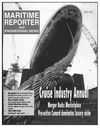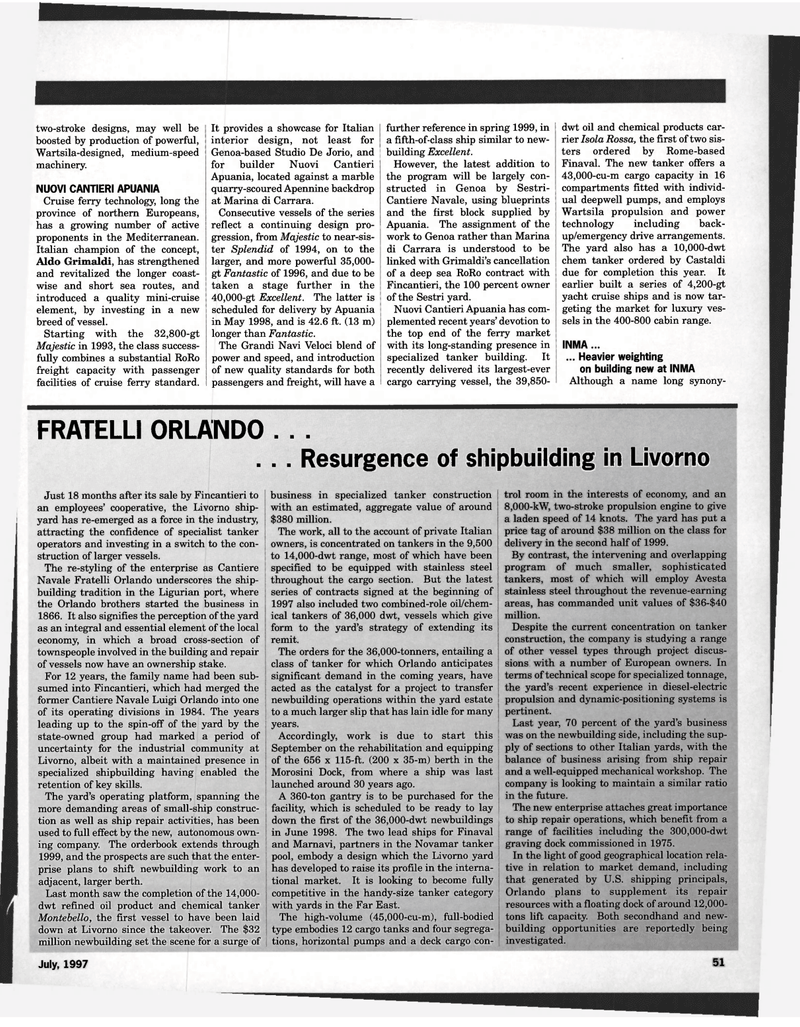
Page 51: of Maritime Reporter Magazine (July 1997)
Read this page in Pdf, Flash or Html5 edition of July 1997 Maritime Reporter Magazine
two-stroke designs, may well be boosted by production of powerful,
Wartsila-designed, medium-speed machinery.
NUOVI CANTIERI APUANIA
Cruise ferry technology, long the province of northern Europeans, has a growing number of active proponents in the Mediterranean.
Italian champion of the concept,
Aldo Grimaldi, has strengthened and revitalized the longer coast- wise and short sea routes, and introduced a quality mini-cruise element, by investing in a new breed of vessel.
Starting with the 32,800-gt
Majestic in 1993, the class success- fully combines a substantial RoRo freight capacity with passenger facilities of cruise ferry standard.
It provides a showcase for Italian interior design, not least for
Genoa-based Studio De Jorio, and for builder Nuovi Cantieri
Apuania, located against a marble quarry-scoured Apennine backdrop at Marina di Carrara.
Consecutive vessels of the series reflect a continuing design pro- gression, from Majestic to near-sis- ter Splendid of 1994, on to the larger, and more powerful 35,000- gt Fantastic of 1996, and due to be taken a stage further in the 40,000-gt Excellent. The latter is scheduled for delivery by Apuania in May 1998, and is 42.6 ft. (13 m) longer than Fantastic.
The Grandi Navi Veloci blend of power and speed, and introduction of new quality standards for both passengers and freight, will have a further reference in spring 1999, in a fifth-of-class ship similar to new- building Excellent.
However, the latest addition to the program will be largely con- structed in Genoa by Sestri-
Cantiere Navale, using blueprints and the first block supplied by
Apuania. The assignment of the work to Genoa rather than Marina di Carrara is understood to be linked with Grimaldi's cancellation of a deep sea RoRo contract with
Fincantieri, the 100 percent owner of the Sestri yard.
Nuovi Cantieri Apuania has com- plemented recent years' devotion to the top end of the ferry market with its long-standing presence in specialized tanker building. It recently delivered its largest-ever cargo carrying vessel, the 39,850- dwt oil and chemical products car- rier Isola Rossa, the first of two sis- ters ordered by Rome-based
Finaval. The new tanker offers a 43,000-cu-m cargo capacity in 16 compartments fitted with individ- ual deepwell pumps, and employs
Wartsila propulsion and power technology including back- up/emergency drive arrangements.
The yard also has a 10,000-dwt chem tanker ordered by Castaldi due for completion this year. It earlier built a series of 4,200-gt yacht cruise ships and is now tar- geting the market for luxury ves- sels in the 400-800 cabin range.
INMA ... ... Heavier weighting on building new at INMA
Although a name long synony-
FRATELLI ORLANDO . . . . . . Resurgence of shipbuilding in Livorno
Just 18 months after its sale by Fincantieri to an employees' cooperative, the Livorno ship- yard has re-emerged as a force in the industry, attracting the confidence of specialist tanker operators and investing in a switch to the con- struction of larger vessels.
The re-styling of the enterprise as Cantiere
Navale Fratelli Orlando underscores the ship- building tradition in the Ligurian port, where the Orlando brothers started the business in 1866. It also signifies the perception of the yard as an integral and essential element of the local economy, in which a broad cross-section of townspeople involved in the building and repair of vessels now have an ownership stake.
For 12 years, the family name had been sub- sumed into Fincantieri, which had merged the former Cantiere Navale Luigi Orlando into one of its operating divisions in 1984. The years leading up to the spin-off of the yard by the state-owned group had marked a period of uncertainty for the industrial community at
Livorno, albeit with a maintained presence in specialized shipbuilding having enabled the retention of key skills.
The yard's operating platform, spanning the more demanding areas of small-ship construc- tion as well as ship repair activities, has been used to full effect by the new, autonomous own- ing company. The orderbook extends through 1999, and the prospects are such that the enter- prise plans to shift newbuilding work to an adjacent, larger berth.
Last month saw the completion of the 14,000- dwt refined oil product and chemical tanker
Montebello, the first vessel to have been laid down at Livorno since the takeover. The $32 million newbuilding set the scene for a surge of
July, 1997 business in specialized tanker construction with an estimated, aggregate value of around $380 million.
The work, all to the account of private Italian owners, is concentrated on tankers in the 9,500 to 14,000-dwt range, most of which have been specified to be equipped with stainless steel throughout the cargo section. But the latest series of contracts signed at the beginning of 1997 also included two combined-role oil/chem- ical tankers of 36,000 dwt, vessels which give form to the yard's strategy of extending its remit.
The orders for the 36,000-tonners, entailing a class of tanker for which Orlando anticipates significant demand in the coming years, have acted as the catalyst for a project to transfer newbuilding operations within the yard estate to a much larger slip that has lain idle for many years.
Accordingly, work is due to start this
September on the rehabilitation and equipping of the 656 x 115-ft. (200 x 35-m) berth in the
Morosini Dock, from where a ship was last launched around 30 years ago.
A 360-ton gantry is to be purchased for the facility, which is scheduled to be ready to lay down the first of the 36,000-dwt newbuildings in June 1998. The two lead ships for Finaval and Marnavi, partners in the Novamar tanker pool, embody a design which the Livorno yard has developed to raise its profile in the interna- tional market. It is looking to become fully competitive in the handy-size tanker category with yards in the Far East.
The high-volume (45,000-cu-m), full-bodied type embodies 12 cargo tanks and four segrega- tions, horizontal pumps and a deck cargo con- trol room in the interests of economy, and an 8,000-kW, two-stroke propulsion engine to give a laden speed of 14 knots. The yard has put a price tag of around $38 million on the class for delivery in the second half of 1999.
By contrast, the intervening and overlapping program of much smaller, sophisticated tankers, most of which will employ Avesta stainless steel throughout the revenue-earning areas, has commanded unit values of $36-$40 million.
Despite the current concentration on tanker construction, the company is studying a range of other vessel types through project discus- sions with a number of European owners. In terms of technical scope for specialized tonnage, the yard's recent experience in diesel-electric propulsion and dynamic-positioning systems is pertinent.
Last year, 70 percent of the yard's business was on the newbuilding side, including the sup- ply of sections to other Italian yards, with the balance of business arising from ship repair and a well-equipped mechanical workshop. The company is looking to maintain a similar ratio in the future.
The new enterprise attaches great importance , to ship repair operations, which benefit from a range of facilities including the 300,000-dwt graving dock commissioned in 1975.
In the light of good geographical location rela- tive in relation to market demand, including that generated by U.S. shipping principals,
Orlando plans to supplement its repair resources with a floating dock of around 12,000- tons lift capacity. Both secondhand and new- building opportunities are reportedly being investigated. 51

 50
50

 52
52
